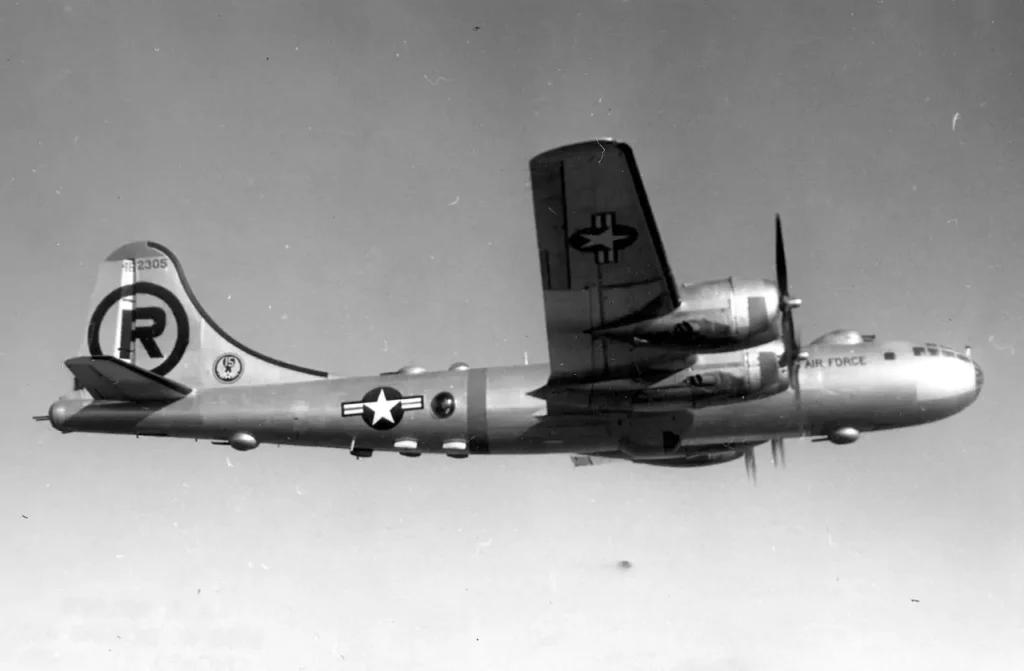Introduction
The Boeing B-29A was the designation for B-29s built at the Boeing plant in Renton.
Production
Between December 1943 and June 1946, Boeing-Renton assembled a total of 1,122 B-29A -BN aircraft, with the first prototype taking flight on December 30, 1943. These models were designed and produced in 16 production blocks, with block numbers reaching as high as seventy-five.
Differences with B-29
The B-29A was in the outside identical to its B-29 counterparts but its main difference was in its wing structure and its method of attachment to the fuselage.
Wing
Unlike the B-29’s single unit inboard wing panels that passed through and were bolted at the fuselage centerline, the B-29A featured a two-piece assembly, with a short stub wing center section installed within the fuselage and wings, bolted to it at station 47.75.
Note: Even though some publications say this change made the wingspan 1 foot longer, the official U.S. Air Force documentation shows that the B-29 and B-29A had the same wingspan.
This structural variation had certain drawbacks. It not only added a weight of 706 lbs due to the heavier structure but also decreased the fuel capacity by around 213 gallons in the center wing tank. This reduction in fuel capacity was not well-received and even prompted criticisms from figures such as General LeMay.

Engines
The B-29A used four R-3350-57 engines for power. Later blocks had a design change in the engine nacelles, with the oil coolers and intercoolers placed more toward the back. This gave them a ‘chinless’ look. This new look was playfully called ‘Andy Gump,’ after a popular comic character of that time.
Armament
Beginning with block 20-BN, the tail 20mm cannon was replaced by an additional machine gun. Also, the upper forward gun turret got two more 50-caliber machine guns. This made the B-29A the only Superfortress with four machine guns in this turret.
In blocks 70 and 75, the upper forward four-gun turret was redesigned into a streamlined teardrop shape, similar to those fitted to B-50s.
Other modifications
- Earlier aircraft models came equipped with a fuel transfer system, while later ones switched to a manifold system.
- Additionally, a formation stick was added to the C-1 autopilot in these later aircraft, an enhancement designed to ease formation flying.
- Some of the first B-29As had bomb-bay doors that used air pressure and could close in less than a second. This was faster than the usual hydraulic doors which needed seven seconds to close. Starting in early 1945, all new B-29s were made with these quicker, air-pressure doors.
Boeing XB-44
A B-29A (42-93845) was transferred to Pratt & Whitney to serve as an experimental platform for the 28-cylinder, four-row Pratt & Whitney R-4360 air-cooled radial engine. This modification resulted in the aircraft being designated as the XB-44.
B-29A Specification
For technical details on the Boeing B-29A please read Boeing B-29A Superfortress Specifications (1950)
Further reading
Bibliography
- Boeing B-29 Superfortress (Crowood Aviation Series) by Steve Pace
- Boeing B-29 Superfortress: The Ultimate Look: From Drawing Board to VJ-Day by William Wolf
- B-29 Superfortress: Giant Bomber of World War Two and Korea by Graham M. Simons